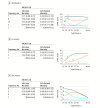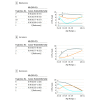Association of Leisure-Time Physical Activity Across the Adult Life Course With All-Cause and Cause-Specific Mortality
- PMID: 30848809
- PMCID: PMC6484624
- DOI: 10.1001/jamanetworkopen.2019.0355
Association of Leisure-Time Physical Activity Across the Adult Life Course With All-Cause and Cause-Specific Mortality
Abstract
Importance: Although the benefits of leisure-time physical activity (LTPA) in middle age are established, the health effects of long-term participation and changes in LTPA between adolescence and middle age have not been documented.
Objective: To determine whether an association exists between LTPA life course patterns and mortality.
Design, setting, and participants: This prospective cohort study used data from the National Institutes of Health-AARP (formerly American Association of Retired Persons) Diet and Health Study established in 1995 to 1996. Data analysis was conducted from March 2017 through February 2018. Data were analyzed for 315 059 adult AARP members living in 6 states, namely, California, Florida, Louisiana, New Jersey, North Carolina, or Pennsylvania, or 2 metropolitan areas, Atlanta, Georgia, or Detroit, Michigan.
Exposures: Self-reported LTPA (hours per week) at the baseline interview for ages grouped as 15 to 18, 19 to 29, 35 to 39, and 40 to 61 years.
Main outcomes and measures: All-cause, cardiovascular disease (CVD)-related, and cancer-related mortality records available through December 31, 2011.
Results: Of 315 059 participants, 183 451 (58.2%) were men, and the participants were 50 to 71 years of age at enrollment. Ten LTPA trajectories (categorized as maintaining, increasing, and decreasing LTPA across time) were identified, and 71 377 deaths due to all causes, 22 219 deaths due to CVD, and 16 388 deaths due to cancer occurred. Compared with participants who were consistently inactive throughout adulthood, participants who maintained the highest amount of LTPA in each age period were at lower risks for all-cause, CVD-related, and cancer-related mortality. For example, compared with participants who were consistently inactive, maintaining higher amounts of LTPA was associated with lower all-cause (hazard ratio [HR], 0.64; 95% CI, 0.60-0.68), CVD-related (HR, 0.58; 95% CI, 0.53-0.64), and cancer-related (HR, 0.86; 95% CI, 0.77-0.97) mortality. Adults who were less active throughout most of the adult life course but increased LTPA in later adulthood (40-61 years of age) also had lower risk for all-cause (HR, 0.65; 95% CI, 0.62-0.68), CVD-related (HR, 0.57; 95% CI, 0.53-0.61), and cancer-related (HR, 0.84; 95% CI, 0.77-0.92) mortality.
Conclusions and relevance: Maintaining higher LTPA levels and increasing LTPA in later adulthood were associated with comparable low risk of mortality, suggesting that midlife is not too late to start physical activity. Inactive adults may be encouraged to be more active, whereas young adults who are already active may strive to maintain their activity level as they get older.
Conflict of interest statement
Figures


References
-
- World Health Organization Global recommendations on physical activity for health. https://www.who.int/dietphysicalactivity/publications/9789241599979/en/. Published 2010. Accessed July 26, 2018. - PubMed
-
- Physical Activity Guidelines Advisory Committee Physical Activity Guidelines Advisory Committee Report, 2018. Washington, DC: US Department of Health and Human Services; 2018.

